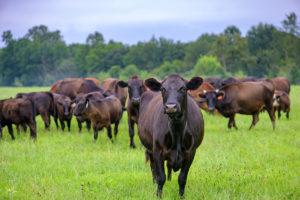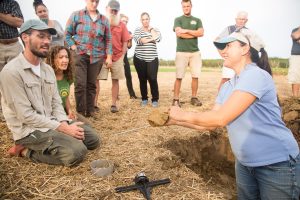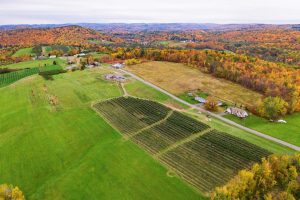Find Farmland
- Getting Started
- Assess Your Financial Readiness
- Find and Assess Land
- Prepare to Lease Land
- Prepare to Buy Land
Getting Started
Finding the right land is a critical step in building a successful agriculture business. The resources below will help get started in your search.
Assess Your Readiness
Some good first steps are to clarify your goals and asses your financial position. When it comes to goal setting, it is important to consider both your personal and your business goals. They should be as “SMART” as possible: Specific, Measurable, Attainable, Results-focused, and Timely.
- Personal Goals – Where do you see your future self? What do you want your life to be? Include family goals, household income goals, and life work balance.
- Business Goals – What kind of farm/ranch do you want to have? Do you want to grow and expand your business or stay small? What is the market for your products? How much income do you need?
Make sure your business goals mesh with your personal goals. Are they consistent? Do you find any differences that need to be addressed?
Use the worksheets below to help you think about where you are, what you want, and what resources you have to get there.
USE
- Acquiring Land to Farm: Where Do I Start? Worksheet
- Personal and Business Goals Worksheet
- Land Tenure Readiness Self-Assessment Worksheet
- Goal Setting Worksheet
WATCH
Think About Your Financial Position

From the start, it is important to know where you stand financially. This will help you decide whether to rent or to buy a farm or ranch, or just raw land, and will affect your ability to borrow money. Think about your
- Current Financial Position: What do you own? How much do you owe to others? What are your income and expenses?
- Future Earning Potential: How much income will your business earn? Do you need off-farm income to support it? Can it pay back a loan?
Next, you need to understand your financial position. This will help you decide how to acquire land. It will also affect your ability to borrow money. You will need several pieces of information to describe your financial position including bank statements, tax returns, credit card or loan statements, and credit reports.
If you are just starting out, you may not have all this information. That is ok. Here are a few things you can do to get started:
- Open a bank account – even a small one.
- File federal and state (if applicable) income taxes.
- Get a credit card. Even if you don’t use it a lot, it will allow you to establish a track record of paying your bills on time and managing credit effectively.
- If you have the resources, establish a retirement account, either through a current employer or on your own, as an IRA. Even a small contribution today will grow over time.
READ
USE
- Financial Documents Checklist
- Land Tenure Readiness Self-Assessment Worksheet
- Balance Sheet Worksheet
Learn more about preparing your finances on the Assess Your Financial Readiness page.
Explore Land Access Options
Land tenure refers to the way people hold their land. There are two basic forms of land tenure: leasing and owning. Land access is the path to acquiring land. It involves land seekers and land holders who may or may not be farmers and ranchers themselves. There are generally three paths to land access: Buying, leasing, and inheriting or accepting gifts of land.
Many beginners lease (or rent) some if not all of their land. This involves an agreement—best served in a written contract—between you and the person who owns the land. It allows a landowner to convey the right to use their property for a period of time in return for some kind of payment. There are different ways to lease, including cash leases and share agreements. Learn more about leasing on the Prepare to Lease page.
Beginners with enough net worth may be able to buy land. When they do, the property’s title transfers to them giving them all the rights and responsibilities that come with of ownership. There are several ways to own or hold land, such as fee title purchase, or fee title purchase of land protected by a conservation easement. Learn more about purchasing on the Prepare to Buy Land page.
Some will inherit or receive a gift of land—often along with a farm or ranch operation—usually from relatives. More information on inheritance is coming soon.
Often beginners use more than one option to build and sustain their operations. Once you have assessed your financial position, you can choose a path which balances your goals and aspirations with the realities of what you need and can afford. It is important to weigh all of your options and keep your personal and business goals top of mind.
Use our Land Requirements Worksheet, to help guide your work. Your final decision likely will be driven by what you can afford, whether you want to build equity, and how much security you require in your land tenure choice.
READ
USE
Connect with Ag Service Providers

Finding land can take years and be financially and emotionally challenging for beginning producers. There are different types of support networks throughout the country who can help.
If you have a chosen location, connect with service providers in your region and talk to them about the type of land situation you are looking for. Sometimes word of mouth is how land seekers find land.
If you have not chosen a location to start a business, explore the resources below for the types of resources that exist and locations where support for agriculture is abundant. You can always contact the Farmland Information Center for advice.
USE
CONNECT
- Farm Link Programs
- Farmland Protection Directory
- Farm Incubator and Apprenticeship Training Projects
- Land Grant Universities and Extension Offices
- National Association of State Departments of Agriculture
- Northeast Farmers of Color Land Trust- Land Network Program
- US Department of Agriculture Office location
- Farmland Information Center
Assess Your Financial Readiness
How much can you afford to spend on rent or a mortgage? It’s important to understand both your personal and your business financial position as well as your income potential so you don’t get in over your head. The resources below will help inform your financial decisions and prepare you to work with lenders.
Identify Key Financial Factors
Some key questions to consider before deciding on a land tenure situation are:
- What are your personal and business goals?
- What is your current financial position?
- What kind of investments do you need to make in your farm or ranch operation?
- What is your earning potential, and
- Can you pay back loans?
It helps to gather a set of financial documents to help you answer these questions. These include bank and investment statements, tax returns, credit card and loan statements, and a credit report.
WATCH
USE
Determine Your Net Worth

Your net worth is the value of your what you own (assets) minus what you owe (liabilities) and is a good summary of your financial position. Lenders and landlords often ask for this information before offering a loan or renting a property. Lenders look at net worth to determine your ability to handle and repay additional debt. Landlords may or may not be interested in your net worth, depending on your relationship with them and the size and scope of the lease obligation. Either way, it is important to have a good understanding of your finances.
To figure out where you stand today, figure out your net worth. Assets minus Liabilities = Net Worth.
A good way to figure out Net Worth is to use a balance sheet, which is a snapshot in time of the financial health of your personal accounts and/or your farm or ranch business. It lists all your assets– from your cash to livestock and inventory, and all your liabilities—from loans to accounts payable.
Some farmers/ranchers combine their business and personal balance sheets, others may keep them separate.
READ
1. Sample Financial Statements
WATCH
PRACTICE
Track Your Income or Losses
It also is important to know where your money comes from and where it goes. Your net income is the difference between all the money you take in and all the expenses you pay.
Income minus Expenses = Net Income. There are many names for the statements which sum this up, including income statement, earnings statement, profit statement, and profit and loss statement.
Net income is positive when the business has more income than expense. You will need positive net income to afford to purchase or even to lease a property unless you have other financial support to help you get started.
READ
WATCH
USE
- Balance Sheet Worksheet
- Ag Decision Maker: Information and decision tool to calculate complete financial statements.
Draft a Cash Flow Budget
 You can use a Cash Flow Statement to track where cash comes from and where it goes. A Cash Budget is basically a forward-looking Cash Flow Statement. It looks at what you think your cash needs will be relative to what you expect for income throughout the year. In agriculture, cash flows often vary by time of year. Your Cash Budget addresses how you will deal with that. Based on your monthly cash flow, you will learn how much you can invest in a land tenure situation.
You can use a Cash Flow Statement to track where cash comes from and where it goes. A Cash Budget is basically a forward-looking Cash Flow Statement. It looks at what you think your cash needs will be relative to what you expect for income throughout the year. In agriculture, cash flows often vary by time of year. Your Cash Budget addresses how you will deal with that. Based on your monthly cash flow, you will learn how much you can invest in a land tenure situation.
USE
Find and Assess Land
These resources will help you find places and specific properties which are suitable for farming or ranching. They also will help you learn to assess if those properties meet your needs.
To make the most of these materials, complete the Land Requirements Worksheet first.
Identify Locations
Start with your personal and business goals and use them to focus on what you really need in a piece of land or a farm or ranch property. Research possible places to find out what kind of farming or ranching is happening there, what grows well, and whether the community is friendly to agriculture. Use your network of other farmers, friends, advisors, and organizations to gather information and make connections.
Find Out About Climate and Growing Conditions
Get to know the region’s climate, growing season, water availability and if there are any issues around water rights. Do they support the kind of operation you want to have? The USDA Plant Hardiness Zone Maps provide information about plant hardiness zones nationwide. from the Census of Agriculture can provide a high-level picture of what grows well and what market opportunities exist in a state or county. In the Census of Ag, choose a state then select Market Value of Ag Products to see they types of crops that are grown in that state
Look into Land Values and Rental Rates
It’s not enough just to find land or a farm or ranch property, you have to be able to afford it! To find out how much it costs to rent or purchase farm properties, you can talk to local contacts and check real estate listings and classified ads. You also can look at data from the USDA National Agricultural Statistics Service including cash rents by county and average agricultural land values by state, region and nationwide, which is updated every year.
State departments of agriculture and Cooperative Extension also are good sources of data. In some states, Extension tracks rental rates for specific types of farm or ranch enterprises
Assess Community Support for Agriculture
Find out if the state and region where you plan to farm has policies and programs that support the kind of operation you want to have. Visit the state, county or municipal website to learn about policies, including property tax relief and Right-to-Farm laws, zoning and other local regulations, which may affect your farm or ranch. See if agriculture is included in the master plan or other local plans, and if so, are local ordinances “farm friendly.” Does the community have a farmers’ market, facilities for aggregating or processing, or there is a “buy-local” campaign. At the local level, start by looking for resources from the Planning Department, Planning Board or Planning Commission. The state’s Department of Agriculture also may have information.
READ

- Census of Agriculture Fact Sheet
- Finding Land Information Sheet
- Community Support for Agriculture Checklist
- Agricultural Land Values Report
- Agricultural Land Values Charts and Maps
USE
- Land Location Comparison Worksheet
- Finding Land Action
- Plant Hardiness Zone Map
- State and County Estimates for Cash Rents
- NASS Land Values Survey
WATCH
Connect with Local Experts
There are a variety of agricultural support services across the country. Different locations have different services. If you are looking in multiple places, reaching out to local contacts will help you learn about the region and build valuable relationships before you relocate. Word of mouth is often a good way to find properties—especially those that have not yet made it to the market.
Reach out to other farmers and farming organizations such as:
- Farm Link Programs Farm Link programs help link beginning farmers and ranchers with retiring ones and land seekers with landowners. Programs may be administered by state agencies or nonprofit organizations. Search our list of Farm Link programs.
- National Young Farmers Coalition NYFC is a national grassroots network of beginning farmers and ranchers working to support each other through policy change, business services, and networking opportunities. Find a local chapter near you.
- National Farmers Union NFU is a membership-based organization who advocates for family farmers, ranchers, fishers, and their communities through education, cooperation, and legislation. Find a local chapter near you.
- American Farm Bureau Federation AFBF is a membership-based organization of farmers and ranchers. They provide access to benefit services, advocacy, and education. Find your state Farm Bureau Office.
Conservation organizations such as:
- USDA Natural Resources Conservation Service NRCS conservationists offer direct, personal assistance, and are often well connected to the local agriculture community. Find a USDA Service Center near you.
- Conservation Districts Conservation District staff can give you maps and help you evaluate soils and develop conservation plans. Visit the Conservation District Directory to find an office near you.
- Tribal Conservation Districts TCD’s are tribal entities in partnership with the USDA, who make available technical, financial, and educational assistance to address the resource needs of all the communities they serve. Find out if there is a TCD near you.
- Cooperative Extension The Cooperative Extension System can test soil samples and assist with writing an agricultural lease, and they are knowledgeable about local agriculture. Find a Cooperative Extension near you.
You can also each out to agricultural experts like:
- American Society of Farm Managers and Rural Appraisers American Society of Farm Managers and Rural Appraisers is a professional association for rural property land experts, with more than 2,100 members nationwide. Members can help beginning farmers and ranchers evaluate land, develop a management plan and determine if the price is reasonable.
- State Departments of Agriculture All 50 states and the territories of American Samoa, Guam, Puerto Rico, and the U.S. Virgin Islands, have a State Department of Agriculture. They offer services to farmers as they work to maintain a safe and secure food supply and to keep farming and ranching economically and environmentally sound. Find a State Department of Agriculture near you.
Learn About Landowners
Think broadly about who might have suitable land for you to rent or to buy. Landowners include farmers, ranchers, and non-operators. They may be individuals or entities which include two or more people. About 40% of farmland is owned and rented out by non-operators who may or may not have farm experience, including individuals, partnerships and trusts, institutions and organizations, and/or public agencies.
Landowners have many reasons and goals for making land available for farming and ranching. These affect rental rates, sales price, the length of and complexity of the process, and the terms of their agreements. Finances play a role but money may not be the only or the driving force. While some people see land simply as a financial investment, others want to ensure it stays in farming forever. Still others just want to keep it in the family regardless of how it is used. Public entities may have a purpose to protect health and safety. To have successful negotiations, it is useful to know what the landowner wants and why they are making their land available. It also is important to find out how much they know about agriculture and what they need to know about your planned operation.
READ
- Landowner Comparison Chart
- A Farmer’s Guide to Working With Land Trusts
- Understanding and Activating Non-Operator Landowners
Assess a Site to Rent or Buy
Before you buy or rent a property, visit and assess the site to make sure it will work for you and our operation. You may want to bring an expert with you to help you find out about the conditions of its soils, buildings, surrounding community and so on.
A site assessment is a systematic evaluation of a specific site in a specific setting. It inventories natural resources like soil and water quality, key features like location, access to roads and services, as well as size, shape, and growing season, and existing farm or ranch assets like buildings, fences, and orchards. A site assessment also looks at prior and current land use, property rights and local regulations that affect farm and ranch businesses.
The purpose of a site assessment is to:
- Identify a site’s qualities and drawbacks for the type of farm or ranch you want to operate
- Assess what it will take to fix any problems
- Compare multiple properties
- Make sure the property meets your personal, financial and business goals
Collect Information
Before you visit a site, plan ahead and be prepared. You can collect a lot of information online and in the community where the land is located (see resources below). At the least, collect soils and topographic maps, groundwater quality ratings, information about local zoning and other land use policies and how much the owner pays in property taxes. If the property meets your needs, you then may want to meet with local officials such as a planner, tax assessor, and/or someone from the water authority or board.
Visit the Site
Be sure to walk the property and plan to visit more than once. The first time you can get a general sense of the property and identify its assets and any potential problems. During future visits, you may want to bring experts with you to help assess conditions and infrastructure. Try to find out about the neighbors or reach out to them directly. Are they farmers or ranchers themselves? Do they seem friendly? Do they support local farms or do they complain about them?
Document What You Find
You probably will assess multiple properties before finding the right fit for you. Make sure to take notes during each visit. You can use this Site Assessment Worksheet to help you keep track of important information as you walk around the property. Make sure to take good notes and carefully evaluate the pros and cons of the parcel.
Practice Due Diligence
Be sure to protect yourself and your new business by doing more tests and assessments when needed. Test the soils and water and look for sources of contamination like underground storage tanks or a tire dump, or problems like poison ivy or oak and invasive species. You may want find experts to help you, like a carpenter or building inspector to look at housing and other structures, or soil scientists, other farmers and agricultural service providers. Tap resources such as Extension, Conservation Districts, USDA, and local agricultural organizations.
READ

USE
- Google Earth: for recent and past imagery
- NRCS Climate Center: a source of climate patterns, water and soil moisture conditions
- NRCS Web Soil Survey: soil maps and interpretations and access to soil survey information
- Plant Hardiness Zones Map: growing season information
- USDA Geospatial Data Gateway: maps, aerial photos
- EPA Drinking Water and Wastewater Laboratory Network: a resource for water quality testing
- Site Assessment Worksheet: a worksheet to help evaluate a parcel of land
- Vineyard Site Assessment Checklist: site assessment tools for data-driven dcision making.
WATCH
- How to Use the Web Soil Survey
- Community Support for Agriculture
- Soil Testing and Management
- Hazards and Cautions
Identify Factors
Location and Configuration
Location is a key piece of a site assessment. Step back and think about the place. Is it in a rural, suburban or urban part of the state? How does this relate to your management system and marketing plan? What is the weather like? Is there good road and highway access? Is it close or far from town? Does it have quality internet and cell phone access? Is housing affordable?
The configuration—or shape and pattern—of the parcel is also important. Is it north or south facing? How much sunlight does it get? Think about the size and orientation of the fields. What are the wind patterns? Are there any physical barriers which would interfere with your operation?
Natural Resources
Land and water are two of the most basic needs of a farm or ranch operation. What kind of soils are there? Are they suitable for your operation? Find out how the site receives water, if there are limits on water use, and if there are any water quality issues. Is there a well or a public water source? Check the topography—or the position of natural and build features and structures in relation to geographical elevation—and decide if it can support your operation. List other natural features like wood land, wetlands, habitat, and threatened or endangered species and think about whether they will work for or against your farm or ranch.
Land Use and Management
Past land uses may affect the quality of the resource and what you can do on the land. It is important to find out as much as you can about land cover and use and how the land was used in the past. Will you need to clear land or restore soil fertility? Will you need to transition any fields to organic production (which could take three years)? Are there easements or other restrictions which might affect your operation?
Property Rights and Potential Limitations
Properties come with a “bundle of rights” within the limits of local, state, and federal laws and regulations. These rights include the right of possession which means if you hold title to the property, it’s yours. They also include the right of control, which means the owner can do pretty much whatever they want with it within the limits of the law, the right of exclusion so you can stop unwanted people from entering or using your property, and the right of disposition, which means as long as you hold title, you can sell, rent, or transfer ownership or use of the property however you want .
Property ownership also comes come with responsibilities so it is important to know if any of the rights that you might want to enjoy have been limited in any way. One of the biggest responsibilities is financial: you have to pay taxes and maintain your property, and you likely will have to pay off loans and a mortgage. You have to respect local ordinances and zoning, as well as any state or federal laws which affect how you use your property, such as the Endangered Species Act. If there are easements or other legal restrictions on the land, you will have to uphold them. So when you assess a site, whether or buy or to rent, it is wise to find out if there are any limits to its use which might affect your operation.
Carrying Costs
Land is expensive—not just to buy or to rent but also to maintain. Finding out about rental rates and land prices is important but they are only the start. When you think about the costs of a land tenure situation, also think about property taxes and any special assessments like fire protection, water, energy, broadband, and other utilities. Will you need to invest in any long term improvements like fencing or irrigation, restore any fields, clear invasive plants, and if so, what will this cost?
Community Support for Agriculture
A supportive community can make a big difference in the success of a farm. Most communities have a master plan (also known as a general, land use or comprehensive plan) to guide its future actions and local policies. This is a good place to find out if a county, city or town supports agriculture and if so, how. Does the plan talk about agriculture, does it say that farms and ranches are important? Or does it ignore them? Most communities rely on zoning to regulate the who, what, when, where, and how of new activities and development, and set standards for different kinds of land use. Find out if local zoning protects and encourages farms and ranches or limits their activities. Use the Community Support for Agriculture Checklist to think about and track a specific community
READ

- Agriculture Conservation Easements
- Purchase of Conservation Easements
- Beginning Farmers’ Guide to Conservation Easements
WATCH
- Location and Configuration
- Soil Testing and Management
- Infrastructure and Improvements
- Land Use and Management
- Rights and Limitations
- Carrying Costs
USE
Analyze the Results
After you have collected information, visited sites and documented your findings remember to compare what you found with your financial, business and personal goals. Refer to your land requirements list and update it based on what you saw. Reference your completed checklists and worksheets that we provided above to help narrow down your decision.
READ
- Guide to Finding, Assessing and Securing Farmland: A Plain Language Guide
- Finding Land Information Sheet
- Land Owner Comparison Chart
USE
Prepare to Lease Land
These resources will help you compare types of leases, interpret lease terms and assess landowner requirements. You can use this information to determine the type of leasing arrangement that most closely aligns with your personal and business goals.
To make the most of these resources, complete the Personal and Business Goals Worksheet, the Financial Self-Assessment Worksheet and the Land Requirements Worksheet.
Learn About Leases
A lease is a contract that spells out the relationship between landowner and tenant. It includes a description of the property, length of the lease, payment terms and rental rate. Oral leases are common and usually valid for a year. But they offer few protections, so it is worth the time and effort to develop a written lease agreement.
There are two main types of leases. Cash leases require regular cash rental payments in exchange for use of the property. Share agreements are based on production yields and operating expenses are shared between the landowner and operator. Ground leases are becoming more common. They are long term arrangements where the tenant rents the land but invests in and owns the buildings and other improvements
What’s in a Lease
Key elements of a lease include a description of the parties entering into the agreement, a property description, the length of the lease, and payment terms including rental rate. It should spell out who is responsible for maintenance and improvements. It can include conservation provisions and recommended practices and management systems to improve soil health protect natural resources.
Determine What You Need
To get started, keep your personal and business goals at the fore front of your lease exploration. Talk to other local farmers and ranchers, Cooperative Extension agents or other service providers in your area to find out about typical leasing arrangements. Also look at some sample leases to help you think through how different terms and provisions will affect your operation and goals.
Don’t forget to think about who is responsible for long term investments in the property. To implement practices such as improved drainage and investments in soil health you might need the assistance of your landowner. For longer term investments consider negotiating shared costs, lower rental rates, or longer-term lease agreements.
READ
- Farmland Access Legal Toolkit: Leasing
- National Agricultural Law Center- Agricultural Leases: An Overview
- Farm Lease Terminology
- Elements of a Good Lease
- Ag Lease 101
WATCH
USE
CONNECT
- Cooperative Extension Directory – You can use this map to locate Extension agents in your region.
Find Rental Rates
Figuring out a good rental rate is tricky. It varies based on region, type of operation, landlord, and type of lease. It is easier to find information in some parts of the country, such as the Midwest, and generally more straightforward for cash rents. As you prepare to negotiate, find out about any benchmarks or averages for rental rates in your area.
You can get a general sense of rental rates from USDA National Agricultural Statistics Service data. Cooperative Extension typically has more specific, localized data and in some regions has developed rental rate calculators for specific commodities. Other resources include the Society of Rural Appraisers and Farm Managers and real estate agents who could help estimate parcel specific data about sale prices. Be aware that these average rental rates may not apply to your situation.
In some places you can find rental rate calculators. Here are two examples:
READ
USE
- Cash Flow Budget Worksheet
- Land Access Calculator
- USDA NASS – Information about Cash Rents: You can use these to customize for your locale.
Negotiate a Good Farm Lease
Knowing what you need is an important first step to negotiating a good lease. It is also important to understand what the landowner wants and needs. Farmers and ranchers can lease land from other operators or non-operator landowners including individuals, institutions, organizations, and public agencies.
Different landlords have different motivations. A retired farmer may want to see the land managed as it has been, while a non-farming landlord may not be familiar with agricultural management. A land trust or public agency may have a public purpose that requires specific types of operations or conservation practices or may limit construction of agricultural infrastructure.
Building relationships takes time. Open communication both in negotiating a lease and throughout the term of the lease helps landlords and tenants find a common ground. Talk often, be realistic on rates, and demonstrate dependability to build trust.
READ
- Drafting a Good Lease: Questions for Farmers and Landowners to Ask
- Landowner Comparison Chart
 Managing Landlord-Tenant Relationships
Managing Landlord-Tenant Relationships- How to Negotiate a Fair Land Rental Agreement
- Retain and Improve Rented Land
- Building a Common Vision: Communication and Relationships
- Negotiating Reasonable Land Rent in Times of High Market Prices
WATCH
USE
Prepare to Buy Land
These resources will help you describe the bundle of rights associated with property ownership, the elements of a land contract and the steps required to close a deal, including tax considerations and lender requirements.
To make the most of these resources, complete the Personal and Business Goals Worksheet, the Financial Self-Assessment Worksheet, and the Land Requirements Worksheet.
Learn About Ownership
It is important to understand the rights and responsibilities that go along with ownership. Owning real estate comes with a “bundle of rights” including the right of
- Possession: If you hold title, it is yours and you have the right to occupy it.
- Control: You have control over what you do with your property subject to applicable federal, state and local laws.
- Use and enjoyment: You have the right to use your property.
- Exclusion: You have the right to prevent others from using or entering your property.
- Disposition: You can sell or transfer your property in whole or part. This includes selling or donating an agricultural conservation easement to keep land available for agriculture.
Along with these rights come responsibilities. There are financial obligations such as paying your mortgage and property taxes, maintaining the property, and insuring against liabilities. You must also follow applicable local, state and federal laws. Before you buy land, be sure you understand and are willing to take on the full costs and obligations over time.
READ
- How a Traditional Farm Sale Works
- Considerations for Farm Buyers
- Ownership Rights in Real Property
- Small Farm Tax Guide
- Guidance for Heirs Property Operators Participating in FSA programs
Assemble Your Team
Buying a farm or ranch is a big commitment. It is important to pull together a team of professionals who can provide financial assistance and help you purchase the best property for you. Key professionals to reach out to include:
- A farm advisor can walk the property with you to help you determine if the property aligns with your plans for your farm or ranch business. Advisors could include Cooperative Extension agents, someone from NRCS, your local Conservation District, a Tribal Conservation District, or State Department of Agriculture. An advisor could also be another farmer or someone in the community who is connected to the local food system.
- A lender can assist with financing. There are lenders, such as Farm Credit System, who specialize in farm and ranch services.
- A Real estate agent can help you learn about the market, locate suitable properties, and help you navigate the process of closing a deal. Look for one familiar with agriculture and transferring large estates. If possible, find a “buyers broker” who works for you since most real estate agents work for the seller.
- A qualified accountant can help you gather financial information for your loan, and can help you develop financial statements for your business to understand your short- and long-term tax situation. Try to find an accountant you trust and who is familiar with farm/ranch taxes. Your accountant may also provide guidance on tax deductions for long-term assets like orchards or barns to reduce the amount you owe.
- An appraiser will assess the monetary value of a property you are considering.
- An attorney will help you handle the necessary legal parts of the deal.
READ
CONNECT
- Cooperative Extension
- USDA Natural Resources Conservation Service (NRCS)
- Conservation District
- Tribal Conservation District
- National Association of State Departments of Agriculture – State Directory
- Farm Credit System
- Society of Rural Appraisers and Farm Managers
Make Sure the Property Meets Your Needs
As you prepare to purchase land, be mindful of the requirements you identified using the Land Requirements Worksheet. Use the Site Assessment Worksheet to help you focus on key considerations and capture consistent information when looking at multiple properties.
Confirm that you can afford it! What you can afford is a combination of your business and personal financial picture. Refer to your Financial Self Assessment Worksheet to verify how much you can put toward the purchase on a monthly basis. Keep in mind that for most lenders, your total debt should represent no more than 40 percent of your gross income.
Remember to consider the total costs of ownership. Beyond the down payment and mortgage payment, find out how much it will cost to support the property once you buy it.
- Talk to the local tax assessor about local property taxes.
- Ask the seller for copies of utility and insurance bills.
Think about how the purchase will affect your income tax picture. You may want to work with an accountant to help you set up how you will do your taxes for as long as you own the property. Consider having a special appraisal done after you buy the property that you can use as the basis for future tax treatment. This is worth the upfront investment because it can save you a lot of money over time.
To calculate the amount you can deduct from your taxes, your accountant will work with you to identify the personal and business assets you have purchased. It is likely you will need to have a separate appraisal done to formally value the assets on the land, especially if the property is also your residence.
WATCH
USE
- Land Requirements Worksheet
- Site Assessment Worksheet
- Financial Self-Assessment Worksheet
- Land Affordability Calculator: National Young Farmers Coalition
Prepare for Credit
Learn about Lending
The first step on the path to securing credit is to learn the basics about agricultural lending. Understanding how lenders review loan applications and what information they require will help you get ready. Lenders usually consider your financial position, credibility and other traits of your character. Each lender may weigh these factors a little differently. It is worth the time to do some research to understand your lender’s priorities.
Keep Records
Good record keeping allows you to set and track progress toward your financial goals, enables you to make informed decisions about your business, and demonstrates your ability to generate revenue and pay off debt. Financial records provide the data you need to prepare financial statements that lenders may require with the loan application. To approach a lender, you will likely need:
Statement of personal assets and debts
- Balance sheet and income statements
- Business plan and cash flow budget
- Credit report
- Production histories
- Tax returns
In general, provide records for three years unless your business is newer.
Develop a Plan
A business plan is a written document outlining the goals, strategies, and action plans for important areas of your farm or ranch operation, including management, finance, production, and marketing. It should include enough information so that other people understand what you want to do and how you plan to do it.
Know Your Credit Score
Your credit score shows your ability to borrow money and pay it back, pay bills on time and act in a financially responsible way. Before applying for a loan, know your score and be prepared to answer questions a lender might have about your credit history. The Fair Credit Reporting Act (FCRA) requires each of the nationwide credit reporting companies—Equifax, Experian, and TransUnion—to provide you with a free copy of your credit report, at your request, once every 12 months.
Identify a Lender
It is a good idea to check out all available financing options. You may use different funding sources to cover different costs. Some lenders have specific programs for beginning producers.
The Farm Credit System was established to provide a reliable source of financing for farmers. FCS is a nationwide network of borrower-owned lending institutions and specialized service organizations that provide loans and other services to agricultural producers, rural homeowners, aquatic producers, timber harvesters, agri-businesses, and agricultural and rural utility cooperatives.
Your local bank may also be a potential source for credit. Many banks participate with state agencies to provide financing to beginning farmers through state loan programs, including “Aggie Bond” Programs”, and may offer loans guaranteed by USDA Farm Service Agency. Although it is uncommon, some banks have created local financing initiatives that link funds from depositors to a special lending pool available to beginning farmers. Ask your local bank if such a program is available.
State finance programs provide low interest loans, loan guarantees, and loan participation programs to help producers buy land, buildings, equipment, and breeding livestock. Some programs, including “Aggie Bond” programs, are targeted specifically to beginning farmers. The National Council of State Agricultural Finance Programs tracks available programs and produces a comprehensive directory of state-level programs available to beginning and established producers.
The USDA Farm Service Agency (FSA) provides direct and guaranteed loans to farmers and ranchers unable to obtain financing from other lenders for operating expenses and land purchases. Microloans are direct farm operating loans with a shortened application process and reduced paperwork designed to meet the needs of smaller, non-traditional, and niche type operations.
READ

- Farm Service Agency Loans: The Ins and Outs of Growing a Farm with Federal Loans
- The Farmer’s Guide to Agricultural Credit
- Financing Agriculture: The Business Borrower-Lender Relationship
- How Lending Decisions Are Made
- How to Get a Free Credit Report
- Your Guide to FSA Loans
- Highly Fractionated Indian Land Loan Program
USE
- Recordkeeping Samples and Templates from University of Georgia
- Establishing and Using a Farm Financial Record-Keeping System
- Preparing Agricultural Financial Statements
- Guide to Developing a Business Plan for Farms and Rural Businesses
- Strategic Business Planning
- Lender Document Checklist
- Free Annual Credit Report Service
- Land Acquisition Action Plan
CONNECT
- Farm Credit Find a Lender Tool
- USDA Service Center Locator
- The National Council of State Agricultural Finance Programs Directory of State Finance Programs
Close the Deal
Once you have selected a property, you will need to organize and understand your legal documents and conduct a close inspection of the property. Also identify local land use regulations, including zoning, local right-to-farm laws, or if the property is in an agricultural district. Inspect your property and ask your real estate agent what kind of state inspections are required. Identify waters sources, and contact NRCS to help with a site assessment and soil survey. When you conduct an environmental site review, look for things like tire dumps and garbage as well as hazardous materials such as underground storage tanks. Assess the conditions of buildings and other infrastructure, septic system, and know sources for water and boundary rights.
Purchase and Sale
Review legal documents including the title, survey, and deed to the property. A Purchase and Sale (P&S) agreement is a legal document that is typically written at the point of sale and reviewed by an attorney. Often it is created by a real estate agent using a standardized form, which is why it is so important to involve an attorney to make sure your interests are protected. The Purchase and Sale Agreement includes details of what is being bought and sold, and the condition of the property, and the final sale price and all terms of the purchase, closing conditions and termination provisions to cover things such as the buyer cannot secure financing. The buyer signs the contract first and includes a deposit, which will be held in an escrow account until closing. When the seller signs the agreement it becomes a fully executed contract.
Title
After the Purchase and Sale Agreement is signed your attorney will conduct a check for clear title, which is the legal way of saying you own the property “free and clear”. A clear title also means there aren’t any liens on the property or heir property issues. Not having clear title may make it hard to borrow money. Most lenders require you to purchase a lender’s title insurance policy, which protects the amount of money they lend to you. This will include a title search to ensure clear title.
Deed
A deed is a legal document that transfers title from one person to another. A deed may be a single page or only a few pages long. But even though it is short, it’s a complex legal document and includes a legal description of the property that is being conveyed. Review the deed carefully. Check to see if the grantor’s legal name and signature correct, that the boundaries are clear, if the legal description is correct, and if there are any encumbrances. An encumbrance is a claim or liability against real estate that is held by someone other than the fee owner of the property. An encumbrance will affect the title to the property and therefore its value. Encumbrances include property liens, deed restrictions, easements, and encroachments. An encumbrance may transfer with the property so it is really important to find out about them. Pay special attention to agricultural conservation easements in a deed. They permanently protection farmland, which may make land more affordable, and supports land access and farmland succession. But they also limit what you can build on the property and where, require regular monitoring and engagement with a land trust or government agency.
Agricultural Conservation Easements
In places where they are relevant, agricultural conservation easements are worth extra attention as they are an effective way to transfer land between generations and often keep land more affordable for farming and ranching. However, they are permanent and run with the deed, and they come with restrictions that are enforced by a qualified entity, so make sure you review the legal documents carefully.
-Increasingly, state and local farmland protection programs (Purchase of Agricultural Conservation Easement programs) are getting involved in farmland transition and land access for beginning farmers. Delaware has a Young Farmers Farmland Purchase and Preservation Loan Program; Maryland just started what is effectively a first time farm buyer program, oriented toward young and beginning farmers. Frederick and Carroll Counties in Maryland have Critical Farms Programs, and some progressive land trusts – especially agricultural land trusts – are getting involved in farmland access issues, especially leasing land but also keeping it affordable and offering technical assistance and support around land access.


